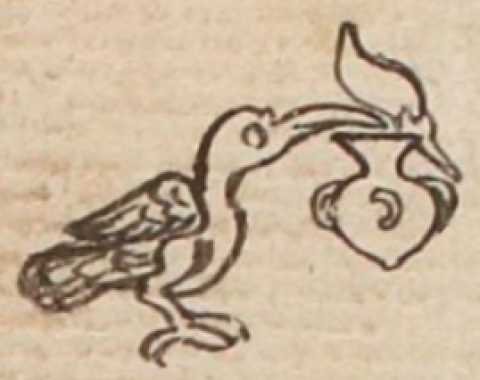Coco (Verg8v)
This black-line drawing of the compound glyph for the personal name Coco (perhaps “Female Domestic Servant,” attested here as a man’s name) includes three elements. On the left is a bird, shown in profile, facing toward the reader's right. This bird might be the coxcox, but there are no indications to suggest this other than the fact that the name is somewhat similar, having a similar reduplicated element, and so it may be serving a phonetic role as a semi-homophone. On the right, at the top, is a chile pepper. Perhaps this pepper provides a phonetic indicator for cococ, which refers to its notable spiciness and serves as a similar semi-homophone. Finally, below the pepper is a ceramic jug (comitl), which provides a final phonetic value for one of the "co" syllables.
Stephanie Wood
This compound seems to be fully phonographic, given that no single element refers to a domestic servant--if that, indeed, is what the name is meant to be and not the bird called coxcox. We do have two glyphs in the collection for that bird.
Stephanie Wood
mrn. coco
Martín Coco
Stephanie Wood
1539
Jeff Haskett-Wood
chiles, cantaros, cerámica, barro, jugs, ceramics, chile peppers, spicy, picante, ollas, jarras, ave, aves, pájaro, pájaros, pluma, plumas, animals, animales

coco, female domestic servant, https://nahuatl.wired-humanities.org/content/coco
cococ, hot pepper, https://nahuatl.wired-humanities.org/content/cococ
co(mitl), ceramic jug, https://nahuatl.wired-humanities.org/content/comitl
Codex Vergara, folio 8v, https://gallica.bnf.fr/ark:/12148/btv1b84528032/f24.item.zoom
The non-commercial reuse of images from the Bibliothèque nationale de France is free as long as the user is in compliance with the legislation in force and provides the citation: “Source gallica.bnf.fr / Bibliothèque nationale de France” or “Source gallica.bnf.fr / BnF.” We would also appreciate a citation to the Visual Lexicon of Aztec Hieroglyphs, https://aztecglyphs.wired-humanities.org/.





